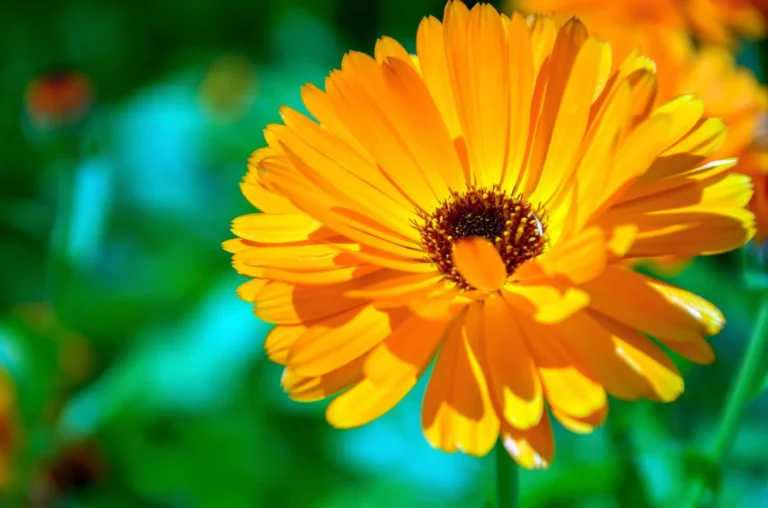Calendula, also known as pot Marigold, is a stunning Mediterranean plant with a daisy-like appearance that is part of the Asteraceae family. It is often grown as an annual flower in cooler climate zones, but in warmer climates, it is a short-lived perennial.
Today, gardeners enjoy these plants for their vibrant, cheerful flowers that bloom quickly after planting in the spring. With a range of colors from subtle shades of pink and cream to bright yellow, orange, and red, calendula is a popular choice for garden beds and containers.
Most common Marigold varieties:
- Bambino
- Bolero (French marigold)
- Brocade
- Colossus Red Gold
- Court Jester
- Golden Guardian
Care
Calendula is easy to take care of, and can also tolerate poor conditions. You need to keep in mind that it needs full sun but may wilt in extreme heat. A quick tip: pinching back young plants promotes compact, bushy growth, and deadheading old flowers encourages reblooming.
- Soil: Calendula plants prefer well-drained soil high in organic material and can tolerate a wide range of soil pH but prefer slightly acidic to neutral soil.
- Water: It is very important to avoid overwatering these plants. Water them frequently until they are established, after which mature plants only need occasional watering.
- Light: Calendula plants usually prefer full sun but may require some afternoon shade during the hottest months to avoid wilting.
- Temperature: it likes mild summer temperatures but can die in very hot climates, while a hard freeze can also kill the plant. Just protect the plant from frost with a blanket or three to four inches of mulch.
Propagation
Propagating calendula plants is pretty straightforward so beginner gardeners are in luck here. Just start by germinating seeds indoors in a seed starter mix about 6 to 8 weeks before the last frost or sow them directly into the garden just before the last spring frost. These plants will also readily self-seed in the garden, but don’t mistake the seedlings for weeds.
You can also propagate them by taking cuttings (like propagating Elephant Ears), but using seeds is the most common method.
Pruning
Marigolds are generally low-maintenance plants that can benefit from pruning to enhance their bushiness and encourage continuous blooming.
To prune marigolds effectively, locate the flower stem and carefully trim it just before the first set of leaves, being cautious not to harm the leaves themselves. This area is vital for generating new stems and flowers.
When pruning, look out for fading flowers with brown, curling petals or green centers, as the latter indicates seed pod development, hindering blooming. Remove such flowers promptly.
Pinching back weak or elongated stems promotes bushier growth and more flower buds. Remove any diseased parts and consider an annual pruning of at least two-thirds of each stem after blooming. Pruning can be done by hand or with pruners.
Common Pests
- blister beetles
- tarnished plant bugs
- spider mites
- thistle butterfly caterpillars
- slugs
- flea beetles
- cucumber beetles
- whiteflies
- aphids
Frequently Asked Questions
Calendula plants usually self-seed from year to year. It is an easy-to-grow annual that flowers from summer to early autumn, perfect for summer borders and containers, and its flowers can be used for cutting, as well as edible petals and skincare products.
Is calendula easy to grow?
Calendula is pretty easy to grow. Just start by germinating seeds indoors in a seed starter mix about 6 to 8 weeks before the last frost or sow them directly into the garden just before the last spring frost.
Can calendula survive winter?
Calendula plants cannot survive harsh northern winters, but they can bloom all winter long in warmer climates.
Can I grow calendula from cuttings?
Yes, you can grow calendula plants by taking cuttings, although growing them from seeds is the most common method.

